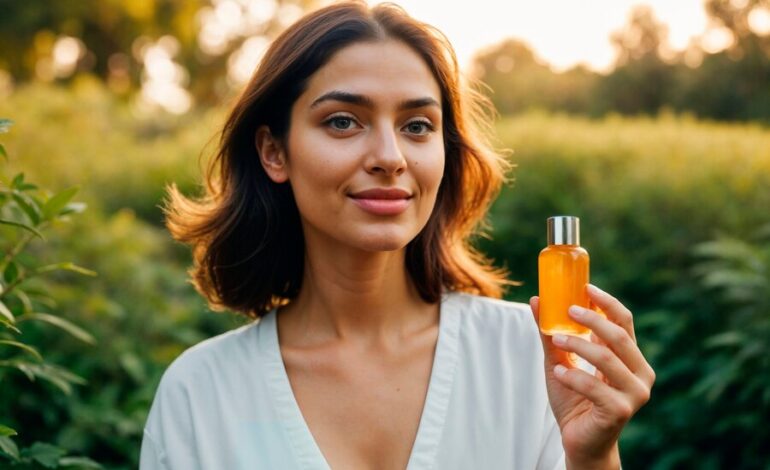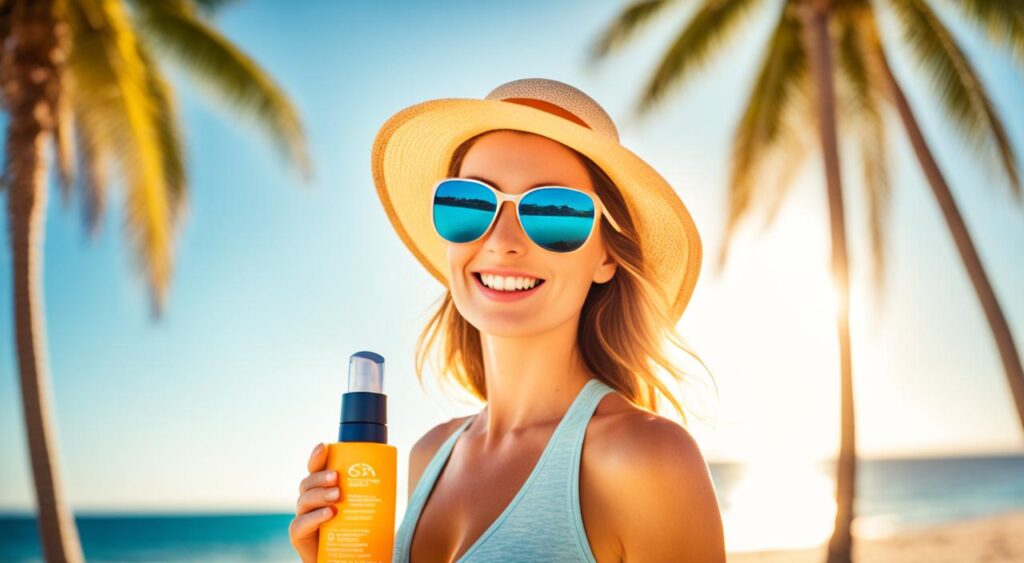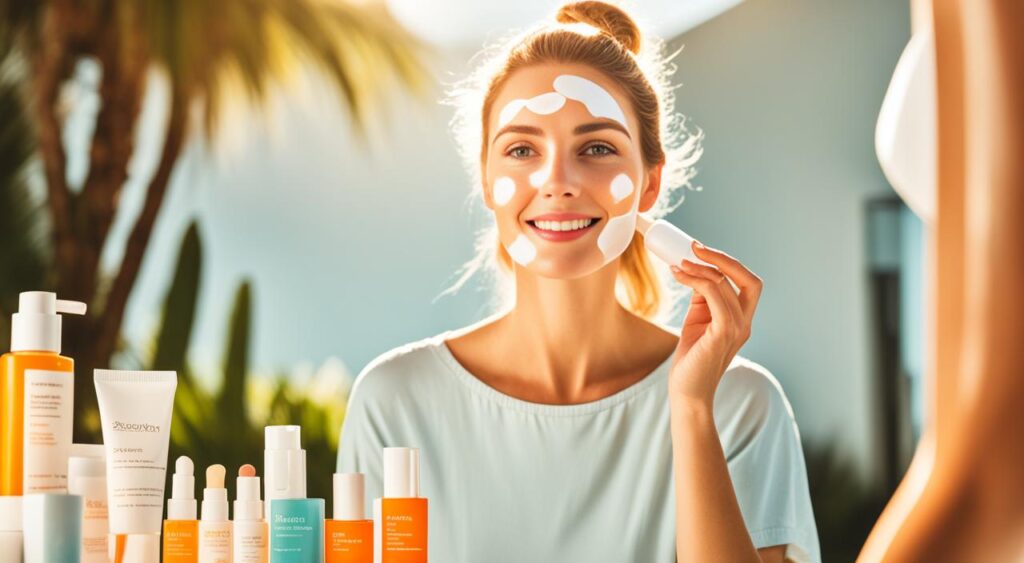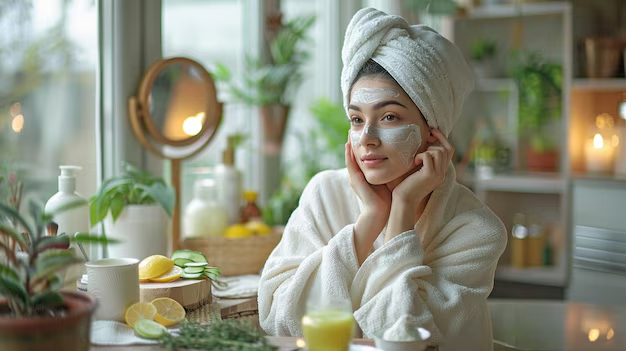Can Sun Spots Be Prevented With Proper Skincare?

Being in the sun can lead to sun spots. These are also called age spots or solar lentigines. They are flat, brown spots found on the face, hands, and shoulders. Too much sun makes the skin produce more melanin, causing these spots.
Use broad-spectrum sunscreen regularly to avoid sun spots. This helps shield your skin from too much sun. Knowing how to stop sun spots is key to keeping your skin looking young and healthy.
Key Takeaways
- Sun exposure can lead to the development of sun spots, also called age spots or solar lentigines.
- Chronic sun exposure can cause an overproduction of melanin, leading to unwanted brown spots on the skin.
- Regular use of broad-spectrum sunscreen can help prevent sun spots and protect the skin from long-term sun damage.
- Understanding the causes and prevention of sun spots is crucial for maintaining healthy, youthful-looking skin.
- Proper skincare, including sun protection, is key to preventing the appearance of sun spots.
Understanding Sun Spots
Sun spots, also called age spots, happen when our skin gets too much sun. They are dark patches caused by extra melanin, the stuff that makes our skin its color. This is our skin’s way of fighting off sun damage.
Also Read : What Are Effective Home Remedies For Fine Lines?
What Causes Sun Spots?
Spending a lot of time in the sun causes sun spots. The sun’s UV light makes our skin cells produce more melanin. People with lighter skin or those with a family history of sun spots are more likely to get them.
Also Read : How Can You Achieve Glass Skin Naturally?
Common Areas for Sun Spot Development
- Face, especially the forehead, cheeks, and nose
- Shoulders and upper back
- Forearms and the backs of the hands
- Décolletage (chest and neck area)
Also Read : How Do Tomatoes Benefit Your Skin Naturally?
The face, shoulders, arms, and neck are often in the sun. Sun spots commonly show up on these areas. They happen over time from too much sun exposure.
“Sun spots are a visible sign that the skin has been repeatedly exposed to the sun’s harmful UV rays.”
Also Read : How Do Sweet Potatoes Nourish Your Skin?
Preventing Sun Spots

To prevent sun spots, you need a good sun protection plan. Use a broad-spectrum sunscreen with an SPF of 30 or more. Apply it every two hours outside.
Wear things like long-sleeved shirts, pants, and big hats. This helps protect your skin from the sun’s UV rays.
Also Read : How Do Walnuts Contribute To Beautiful, Clear Skin?
Importance of Sun Protection
Using sun protection daily is key in avoiding sun spots. UV rays are the main cause of these marks.
Being sun conscious every day helps keep your skin in good condition. It also lowers the chance of getting sun spots.
Recommended Sun Protection Measures
- Use a broad-spectrum sunscreen with an SPF of 30 or higher.
- Reapply sunscreen every two hours when spending time outdoors.
- Wear protective clothing, such as long-sleeved shirts, pants, and wide-brimmed hats.
- Seek shade during peak sun hours (10 a.m. to 3 p.m.).
Follow these tips to avoid sun spots and more sun damage. Investing in sun protection is crucial for healthy skin.
“The best defense against sun spots is consistent, diligent sun protection. Sunscreen and protective clothing are your skin’s first line of defense against the harmful effects of UV exposure.”
Sun Spots Treatment Options

If you’re dealing with sun spots, also known as age or liver spots, many treatments can help. It’s key to use sun protection to avoid getting more spots. There are both store-bought and professional treatments that can lighten existing sun spots.
You can try over-the-counter products at home. Look for creams and serums with active ingredients like vitamin C, licorice extract, and hydroquinone. They tackle the pigment in sun spots to make them lighter. Using these products consistently can reduce the look of sun spots over time.
If you have a lot of sun spots or they’re tough to fade, consider professional help. A dermatologist might suggest treatments like laser resurfacing, intense pulsed light (IPL) therapy, or chemical peels. These treatments deal with the spots more directly and offer quicker, more noticeable results. They’re effective in lightening or fading sun spots.
Remember, healing from professional treatments may require some time. Also, keep using sun protection to avoid new sun spots and damage. By dealing with the root causes and choosing the right treatments, you can reduce sun spots and keep your skin healthier and more even.
At-Home Remedies for Sun Spots

Many people want to fade sun spots without paying a lot. At-home remedies offer a budget-friendly choice. They use natural items and products you can buy without a prescription. These can help lessen the look of age spots and sun damage.
Natural Ingredients for Fading Sun Spots
Some natural items can make sun spots lighter over time. Here are the best ones:
- Aloe vera – It’s known for keeping skin calm and moisturized. Aloe vera helps stop melanin from being made, which can fade spots on your skin.
- Licorice extract – It has a component called glabridin, proven to make dark sun spots less noticeable.
- Vitamin C – It’s a strong antioxidant. Vitamin C can make your skin tone more even and reduce sun spots.
- Vitamin E – This vitamin helps shield your skin from sun damage. It’s also good for making spots seem lighter.
Over-the-Counter Creams and Serums
Not just natural items, there are also products you can buy. They are made to target dark spots and stop more sun damage. Look for these ingredients when you shop:
- Glycolic acid – It’s a kind of hydroxy acid that refreshes the skin and makes it look brighter.
- Kojic acid – This acid, coming from fungi, can lighten your skin. It works well on sun spots.
- Deoxyarbutin – It helps stop the melanin that causes sun spots without using hydroquinone.
The results of these remedies may not be quick, but they can truly help. Using these products regularly can gradually make your sun spots less noticeable.
Professional Treatments for Sun Spots
If you are looking for quick results in fading stubborn sun spots, consider seeing a licensed dermatologist. They offer advanced treatments that make sun-damaged skin look better. You can get a more even and youthful look after these procedures.
Laser Resurfacing
Laser resurfacing is a top choice for sun spot treatment. It uses beams of light to take off the top layer of damaged skin. Then, new, healthy skin grows. This controlled process helps lessen the look of sun spots and sun damage.
Intense Pulsed Light (IPL)
IPL therapy is also great for treating sun spots. It uses light energy to target the extra pigment in sun spots. This fades the spots over time and through several sessions.
Chemical Peels
Chemical peels are another option for sun spots. They use an acid solution to remove the damaged skin’s top layer. Afterward, your skin looks more even and glowing. This process is good for reducing sun spots and sun damage.
There are also treatments like cryotherapy, which freezes the sun spots off, and microdermabrasion. Microdermabrasion is a gently exfoliating treatment. These methods might have a bit of downtime but can really help reduce sun spots.
Sun Spots and Skin Cancer
Sun spots are usually no big deal. But, it’s important to know the difference between them and skin cancer signs. Always have a doctor check any new or changing spots. This could prevent bigger problems down the line.
Distinguishing Between Sun Spots and Skin Cancer
A few things can make a spot seem more than just a sun spot. These can be a sign of skin cancer:
- Dark or irregular border
- Rapid growth
- Itchiness
- Pain
- Redness
- Bleeding
- Unusual color
If a spot shows any of these signs, see a doctor. They can check if it’s something serious. Quick and correct treatment is key for good skin health.
Sun spots are flat and have clear edges. They’re usually brown or gray, signs of long sun exposure. Meanwhile, skin cancer spots can look different. They might not be uniform and could be changing in various ways.
“Any new or changing spot on the skin should be evaluated by a dermatologist to ensure it’s not a sign of skin cancer.”
Though sun spots are often harmless, stay alert. Any skin changes that worry you need a doctor’s look. Catching and treating skin cancer early can make a big difference.
Maintaining Results After Sun Spots Treatment

Getting clear, even-toned skin after treating sun spots is the start. To keep this beauty, always protect your skin from UV rays. Use a broad-spectrum sunscreen that’s at least SPF 30. Reapply it every two hours outside. Also, wear protective clothing like wide-brimmed hats and long shirts. Find shade when the sun is strongest to stop new sun spots.
Make sun protection a part of daily life. This helps prevent sun spots from coming back. Remember, the sun is the main reason for sun spots. So, staying careful about the sun keeps your results looking good. This applies whether you’ve treated sun spots at home or with a doctor.
| Sun Protection Measure | Benefits |
|---|---|
| Broad-spectrum sunscreen (SPF 30+) | Shields skin from both UVA and UVB rays, preventing further sun damage and sun spot formation |
| Protective clothing (hats, long sleeves) | Blocks direct sun exposure, reducing the risk of sun spots and other sun-related skin concerns |
| Seeking shade during peak sun hours | Limits overall sun exposure, minimizing the chances of developing new sun spots |
Ensuring you’re protected from the sun every day is important. This keeps your skin looking its best for the long run. A routine that guards against the sun is key. It makes sure your skin stays clear and even, no matter what treatments you’ve had.
Sun Spots: A Common Concern
Sun spots are also called age spots or liver spots. They’re common and can worry people. They show up more on lighter skin types with a lot of sun exposure.
As we get older, our skin reacts more to the sun’s UV rays. This makes sun spots more likely to appear. They are darker patches caused by melanin in the skin.
These spots can make people feel uncomfortable. They often show up on parts of the body hit by the sun, like the face and hands. People with them may want to lighten or remove them.
There are many ways to treat sun spots. This includes things you can try at home and treatments by doctors. Some options are using special creams or having laser treatments.
But, always check with a skin doctor if you see new or changing spots. Most sun spots are harmless. Yet, it’s smart to make sure they’re not something more serious.
| Skin Type | Sun Spot Prevalence |
|---|---|
| Fair Skin | High |
| Olive Skin | Moderate |
| Dark Skin | Low |
In the end, sun spots are quite common. They might seem like a big deal, but are usually safe. By knowing how to treat and prevent them, you can keep your skin looking and feeling good.
Also Read: How To Transform Dull Skin Into Radiant Beauty?
Conclusion
Sun spots, also called age spots or solar lentigines, happen when skin sees too much sun’s UV rays. A bit of sun is good, but too much can make your skin’s melanin go into overdrive, causing these spots. To fight sun spots, it’s key to use strong sunscreen, wear protective clothing, and stay in the shade when the sun is strongest.
If you already have sun spots, there are ways to make them lighter. You can try home remedies or see a specialist for treatments. But if you notice any new spots or changes in the ones you have, it’s wise to get them checked by a dermatologist. This helps make sure it’s nothing more serious, like skin cancer. By leading a sun-smart life and dealing with sun spots early, you help your skin stay looking young and healthy.
Keeping your skin safe from UV rays is top priority to avoid sun spots. Wear sunscreen of at least SPF 30 every day, cover up with clothes, and stay away from the sun when it’s strongest. Doing these things helps keep your skin’s tone even. With good sun protection and by acting fast on sun spots, you can enjoy sunny days without worrying about your skin’s health and looks.
FAQs
Q: What are sun spots and how do they appear on the face?
A: Sun spots, also known as age spots or solar lentigines, are flat, brown spots that appear on the skin’s surface due to prolonged exposure to the sun. They tend to appear on areas that are regularly exposed to sunlight, such as the face, hands, shoulders, and arms.
Q: Are sun spots and solar flares the same thing?
A: No, sun spots and solar flares are different phenomena. Sun spots are dark, cooler areas on the surface of the sun, while solar flares are intense bursts of radiation that occur near sun spots and are associated with changes in the sun’s magnetic field.
Q: Can sun spots be prevented with proper skincare?
A: While sun spots cannot be completely prevented, you can reduce their appearance by practicing good skincare habits such as wearing sunscreen daily, avoiding excessive sun exposure, and regularly visiting a dermatologist for skin checks.
Q: How can I lighten sun spots on my face?
A: There are several treatments available to lighten sun spots, including topical creams, chemical peels, laser therapy, and microdermabrasion. Consult a dermatologist to determine the most suitable treatment for your skin.
Q: What causes sun spots on the face?
A: Sun spots are caused by prolonged exposure to the sun’s harmful UV rays, which can lead to an overproduction of melanin in the skin. People with fair skin and a history of sunburns are more prone to developing sun spots.
Q: How do I get rid of sun spots on my skin?
A: To get rid of sun spots, you can try treatments such as topical bleaching creams, laser therapy, cryotherapy, or chemical peels. It is important to consult a dermatologist to determine the most effective treatment for your specific skin condition.
Q: Are sun spots on the face a sign of sun damage?
A: Yes, sun spots on the face are a common sign of sun damage. They indicate that the skin has been exposed to UV radiation over time, leading to the development of pigmented spots on the skin’s surface.





